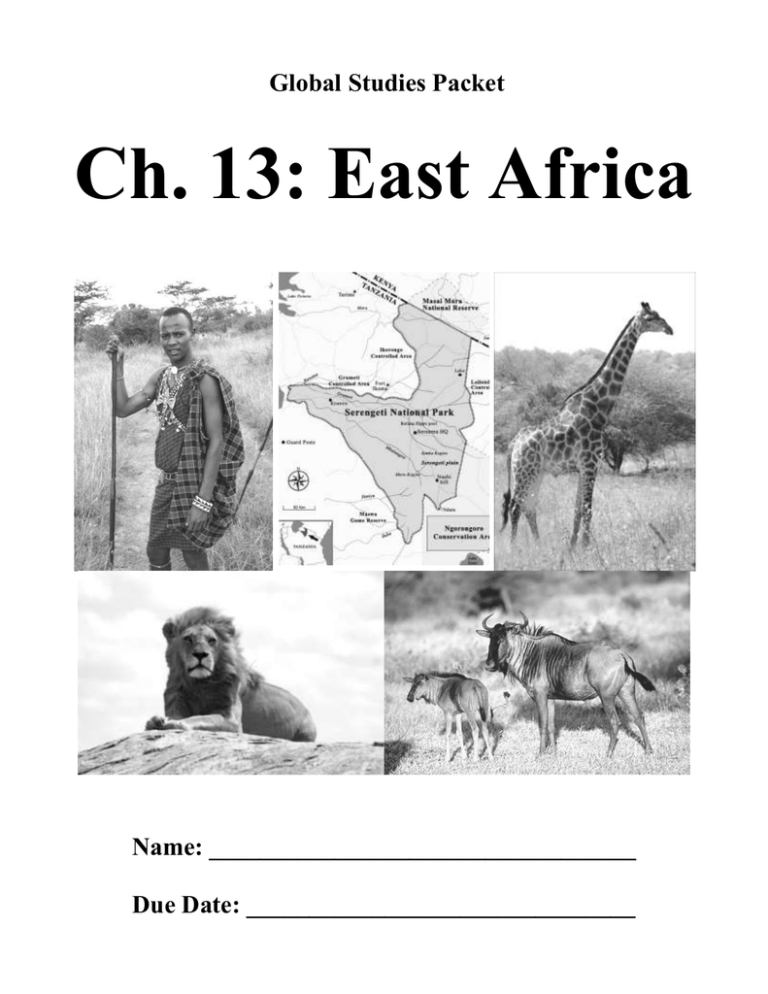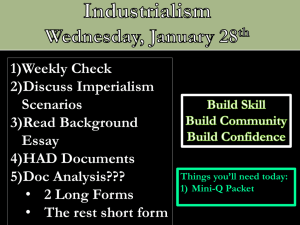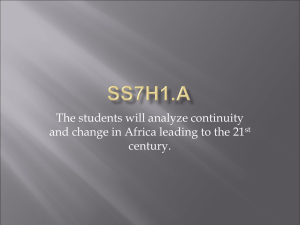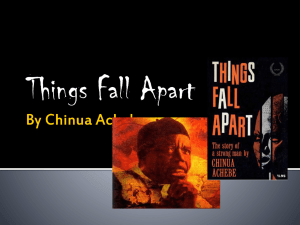Ch. 13: East Africa
advertisement

Global Studies Packet Ch. 13: East Africa Name: __________________________________ Due Date: _______________________________ Vocabulary Define the vocabulary words from page 175. For each term, draw a picture that represents it. Term CLASS WORK Definition Picture PAGE 1 East Africa Map Use page 75 of the atlas or page xxix of your textbook to label the following countries of East Africa. Burundi Djibouti Eritrea CLASS WORK Ethiopia Kenya Rwanda Seychelles Somalia South Sudan Sudan Tanzania Uganda PAGE 2 Wonders of Nature: Serengeti Complete the following while watching the video in class. Spell as best as you can. 1. List 3 facts about the Serengeti. ________________________________________________________________________ ________________________________________________________________________ ________________________________________________________________________ 2. List 8 different species of mammals, reptiles or birds of the Serengeti. *Put a star next to the “Big Five” * _________________________________ _________________________________ _________________________________ _________________________________ _________________________________ _________________________________ _________________________________ _________________________________ 3. List 3 facts about the great migration. ________________________________________________________________________ ________________________________________________________________________ ________________________________________________________________________ 4. List 3 facts about the Masai. ________________________________________________________________________ ________________________________________________________________________ ________________________________________________________________________ CLASS WORK PAGE 3 Age of European Imperialism Use pp. 97-99 of World Cultures: A Global Mosaic in order to complete this activity. Europeans Explore Africa (p. 97) Complete the following chart about the European explorers and their ‘discoveries.” Explorer(s) Where Explorer Was From Mungo Park Scotland Richard Burton & John Speke N/A “Discovery” in Africa Timbuktu Britain European Motives (pp. 97-98) Fill in the blanks with the correct words or phrases. 1. European nations claimed all of Africa except ________________________ and ________________________. ________________________ controlled most of the continent. 2. By the late 1800s, the nations of Western Europe had ________________________. They competed for control of ________________________ for their factories. Africa was a source of ________________________ for soaps, cotton for ________________________, and gum for ________________________. In addition, Europeans looked on African societies as possible ________________________ for the ________________________ produced by European factories. 3. Economic competition went hand in hand with ________________________ rivalries. Europeans built vast ________________________ to boost their place in the world. 4. Some people went to Africa for religious reasons. ________________________ believed that it was their duty to spread the benefits of Western civilization. They thought their religion and civilization were ________________________, so they expected Africans to adopt European ways. CLASS WORK PAGE 4 The Scramble for Colonies (p. 98) Answer these questions in complete sentences. 1. Which two innovations helped Europeans advance into Africa? 2. At what meeting did the Europeans make decisions about dividing Africa? Scramble for Africa Map (p. 99) Use the map to answer the following questions. 1. What does this map show? 2. When was Nigeria colonized? 3. Which European country controlled Togo? 4. Which European country controlled Eritrea? 5. Which European country controlled Madagascar? 6. Which European country had the largest number of colonies? 7. Which two countries remained independent? 8. Which African area became the first European colony? 9. Approximately when most of these areas become colonies? CLASS WORK PAGE 5 Winning Independence Use pp. 107-111 of World Cultures: A Global Mosaic in order to complete this activity. African Nationalism (pp. 107-108) Use the text to define the terms. 1. nationalism- 2. Pan-Africanism- 3. negritude- New Nations Emerge (pp. 108-109) Fill in the blanks with the correct words or phrases. As World War II ended, ________________________ movements gained strength. The war ________________________ colonial powers such as Britain and France. The ________________________ also helped nationalists. The Soviet Union ________________________ imperialism and ________________________ some nationalist movements. Also, the ________________________ spoke out against ________________________. In 1950, Africa contained only ________________________ independent nations- Liberia, Ethiopia ________________________, and ________________________. During the ________________________, African demands of freedom led to the birth of many new nations. Most African nations won independence through largely ________________________ means. In the Gold Coast, strikes and boycotts were used. A boycott is a ________________________ certain goods and services. By contrast, a bitter ________________________ broke out in Algeria. More than ________________________ Algerians and ________________________ French died. In Southern Africa, ________________________ refused to give up its colonies of Angola and Mozambique. Nationalist groups waged guerilla wars against the Portuguese. ________________________ is when small bands of fighters stage hit-and-run attacks against a larger power. CLASS WORK PAGE 6 The Colonial Legacy (pp. 109-111) Answer these questions in complete sentences. Give details. 1. In what ways were the new African nations unprepared for independence? 2. Why were the new national boundaries a problem for the new African nations? 3. What were some of the positive changes made by the colonial powers? Nations of Africa (p. 110) Use the map to answer the following questions. 1. What does this map show? 2. What color represents African nations that became independent before 1945? 3. When did Kenya become an independent nation? 4. When did Ghana become independent? 5. List four nations that became independent in 1960. 6. List two nations that became independent in the 1990s. 7. During which decade did most African nations become independent? CLASS WORK PAGE 7 Cause and Effect War and Famine in the Northeast (pp 177-178) Colonialism in East Africa (pp 184-185) CLASS WORK PAGE 8 Chapter 13 Review Complete the chapter review activities on pages 188 to 189. Write out all answers fully! Vocabulary Review (Write the sentence. Write true or false. If the underlined term is false, change it to make it true. 1. ______________________________________________________________________ ________________________________________________________________________ 2. ______________________________________________________________________ ________________________________________________________________________ 3. ______________________________________________________________________ ________________________________________________________________________ 4. ______________________________________________________________________ ________________________________________________________________________ 5. ______________________________________________________________________ ________________________________________________________________________ Chapter Quiz (Answer in complete sentences. Include the question in your answer.) 1. ______________________________________________________________________ ________________________________________________________________________ __________________________________________________________________(p.181) HOMEWORK PAGE 9 2. ______________________________________________________________________ ________________________________________________________________________ __________________________________________________________________(p.181) 3. ______________________________________________________________________ ________________________________________________________________________ __________________________________________________________________(p.182) 4. ______________________________________________________________________ ________________________________________________________________________ __________________________________________________________________(p.181) 5. ______________________________________________________________________ ________________________________________________________________________ __________________________________________________________________(p.178) HOMEWORK PAGE 10 Chart Skills: Comparing Nations 1. Which nation has the largest population? 2. Which nation has the densest population (most people per square mile)? 3. Which two nations are closest in area? 4. What are Uganda’s chief crops? 5. Which country has the highest literacy rate? 6. Which country has few natural resources? 7. Based on this information, which country do you think is most successful? Explain why. HOMEWORK PAGE 11 HOMEWORK PAGE 12 An African Tale Use the article to answer the questions. Write the correct letters in the spaces provided. _____1. Beatrice is a: A) goat. B) college student. C) little girl. D) charity worker. _____2. If her family hadn’t received the goat, Beatrice would probably never been able to: A) play with her friends. B) go to school. C) ever drink milk. D) learn about animals. _____3. Beatrice is successful mostly because: A) her family received a goat. B) she works hard in school and is an excellent student. C) the goat had babies. D) she was born in Uganda. _____4. Foreign assistance and charity don’t always work because: A) people eat the goats before they have babies. B) most people are too lazy to go to school. C) corrupt government officials steal the aid money. D) the problems are so huge there are no solutions. _____5. What is the author encouraging the reader to do? A) Travel to Africa to learn about its people. B) Work hard in school in order to be more successful. C) Contribute to charities like Heifer International. D) Read the children’s book Beatrice’s Goat. _____6. What is the overall message of this article? A) If spent wisely, foreign aid can help poor people in developing countries like Uganda. B) Every African should receive a goat from a group like Heifer International. C) Poor people around the world should work hard to better themselves. D) Americans don’t care about poor Africans because there is nothing they can do to help. HOMEWORK PAGE 13 Ch. 13 Study Guide Each Friday, we will have a quiz on the week’s packet. The most important things to know are on this study guide. 1. Vocabulary a. define the terms b. use them in sentences c. give examples 2. East Africa Map a. match countries with locations (a practice powerpoint is on Mr. Nolen’s website) b. quiz will include the nations of West and Central Africa (last two weeks’ map) 3. Wonders of Nature: Serengeti a. recall the information from items number 1 and 2. 4. Age of European Imperialism a. identify which European country had the most colonies in Africa b. list reasons why the Europeans wanted colonies in Africa c. identify which two innovations helped the Europeans colonize Africa 5. Winning Independence a. define nationalism b. list things that led to the independence of African nations c. explain why the new national boundaries were a problem 6. Cause and Effect a. be prepared to identify cause and effect STUDY GUIDE PAGE 14






